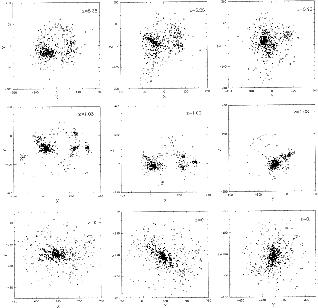


Perhaps the most persuasive evidence for substantial evolution in the look-back time is currently provided by an aspect of observational cosmology also pioneered by Hubble (1926b, 1936c) through his invention of the galaxy classification system. We shall hear much at this workshop of the seemingly drastic difference in galaxy morphology of the galaxies in the HDF images fainter than B = 22 compared with the morphology of nearby samples.
Several years ago, at the invitation of Jerome Kristian, PI of a deep survey GTO project, I classified the faint galaxies on a series of stacked very deep HST frames reaching B = 29 for two fields that were part of the more extended Groth fields that flank the HDF position. As is now well known from other such studies, I also found that the percentage of abnormal galaxies between V = 22 and V 29 is as high as 50% of the total compared with the less than 5% abnormality rate in the nearby sample in, for example, the Revised Shapley-Ames Catalog (Sandage & Tammann 1987). The actual percentages were as follows. Normal spirals, in the sense of the present-day Hubble sequence, are relatively rare at 20%. Normal appearing red ellipticals are present in the significant numbers of 25% of the total. The remaining 55% were divided between mildly abnormal (shreds, interacting multiple components with tides, conglomerants consisting of condensations in a common envelope), and highly irregular forms similar to the local galaxies LMC, SMC, NGC 1313, NGC 1156, NGC 4449, and the pair NGC 4485 / 4490 for example (see the Carnegie Atlas of Galaxies for illustrations).
The significantly larger fraction of peculiar galaxies at the faintest magnitudes is nowadays often attributed to the formation process of galaxies at the moderate redshifts of z > 2, meaning look-back times as short as ~ 2/3 H-10. If so, we have rather direct pictures of how in fact protogalaxies at these intermediate look-back times have become morphologically normal within even the last 2/3 of the time since their protogalactic creation.
The high percentage of multiple forms that are clearly interacting provide a clue to the galaxy formation process. A particularly good example of a conglomerant is shown in Fig. 15 from one of the Kristian fields. Four frames are shown with increasing stretches into the digital record. Only the compact E-like core is shown in the top frame. Fainter components of the structure are shown in the succeeding three frames, showing what appears to be a number of individual components collapsing within a common envelope onto the main E-like core. This could either be interpreted as the "merger" of separate fragments "falling into equilibrium," which is the substance of the conjecture of Searle and Zinn (1978), or as condensations of initial density contrasts within a large, over-arching collapsing envelope that was a single protogalaxy, as in the collapse picture of Eggen et al. (1962, ELS). In the latter case, the formation process is often said to be ELS with "noises" that are the density fluctuations in a lumpy ELS extended envelope that must have been present in the earliest stages of galaxy formation (Sandage 1990). Such a configuration as a function of time is well shown in an early n-body simulation by Zurek, Quinn, and Solman (1988) shown in Figure 16, or as Fig. 26 of Saslaw (1985) in a larger context.

|
Figure 16. N-body simulation by Zurek, Quinn, & Salmon (1988) of a collapse protogalaxy at three different epochs after the initial collapse, as measured by the redshift (look-back time). Projections on the X, Y, Z axes are shown. The description could be ELS with noise. |